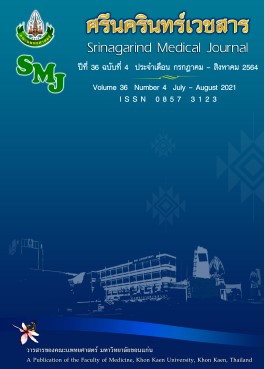Altruism Characteristics of First Year Medical Students, Naresuan University
Keywords:
Altruism; Characteristics; Medical StudentsAbstract
Background and objectives: Being medical professionals involves social commitment including working for others’ benefits rather than for themselves. In the stage where there is a growing sense that physicians’ altruism towards their patients is diminishing, a medical school is obliged to develop such characteristics among their students. This research was conducted to examine the characteristics of altruism in Naresuan University first year medical students.
Method: A cross-sectional descriptive study was conducted. A questionnaire about altruistic characteristics was administered to 175 Naresuan University first year medical students. Frequency, percentages, standard deviation, ANOVA, F-test, and Dunnett T3 for multiple comparisons were used to analyzed the data.
Results: There were 175 participants .The average score of altruistic characteristics of Naresuan University first year medical students was 3.20. It was found that there were statistically significant correlations between the method of admission and the average score at 0.05 level.
Conclusion: Naresuan University first year medical students had altruistic characteristics at a moderate level. However, there were differences among students of different admission methods.
References
2. Jones R. Declining altruism in medicine; understanding medical altruism is important in workforce planning. BMJ 2002; 324(7338): 624–625.
3. Rushton JP, Chrisjohn RD, Fekken GC. The altruistic personality and the self-report altruism scale. Pers Individ Dif 1981; 2(4): 293–302.
4. Pardo DA, Cortina JM. Validation of the Self-report altruism scale test in Columbian University Students. Anfora 2016; 23(41): 17-35.
5. Sanjai S, Vijayaprasad G. Selfless giving in medicine: a study of altruistic attitudes among medical students. Indian J Med Ethics 2018; 3(1): 28-34.
6. Filkowski MM, Cochran RN, Haas BW. Altruistic behavior: mapping responses in the brain. Neurosci Neuroecon 2016; 5: 65-75.
7. Coulter ID, Wilkes M, Der-Martirosian C. Altruism revisited: a comparison of medical, law and business students' altruistic attitudes. Med Educ 2007; 41(4): 341-345.
8. Warneken F, Tomasello M. Altruistic helping in human infants and young chimpanzees. Science 2006; 311(5765): 1301-1303.
9. Batson CD. Altruism in humans. New York: Oxford University Press; 2011.
10. ดวงจันทร์ วรคามิน, ปังปอนด์ รักอำนวยกิจ, ยศวีร์ สายฟ้า. โครงการ “การศึกษาความสามารถด้านการคิดวิเคราะห์และการมีจิตสาธารณะเพื่อพัฒนาศักยภาพการเป็นคนดีคนเก่งของนักเรียนไทย”. กรุงเทพฯ: มหาวิทยาลัยธุรกิจบัณฑิตย์; 2559.
11. Reis HT. Altruism. In: Baumeister RF, Kathleen DV, editors. Encyclopedia of social psychology. Thousand Oaks, Calif: Sage Publications; 2007: 29-30.
12. Gordon JJ, Evans HM. Learning medicine from the humanities. In: Swanwick T, editor. Understanding Medical Education : Evidence, Theory, and Practice. 1th ed. Chichester, West Sussex: Blackwell Pub; 2010: 83-98.
13. เทิดศักดิ์ ผลจันทร์, ไพฑูรย์ ช่วงฉ่ำ. ผลการจัดการเรียนรู้เพื่อการเปลี่ยนแปลงในการพัฒนาคุณลักษณะชีวิตนิสิตแพทย์. พุทธชินราชเวชสาร 2557; 31(3): 396-411.
14. Meza JP, Passerman DS. Integrating Narrative Medicine and Evidence-Based Medicine: The Everyday Social Practice of Healing. New York, NY: CRC Press; 2011.




